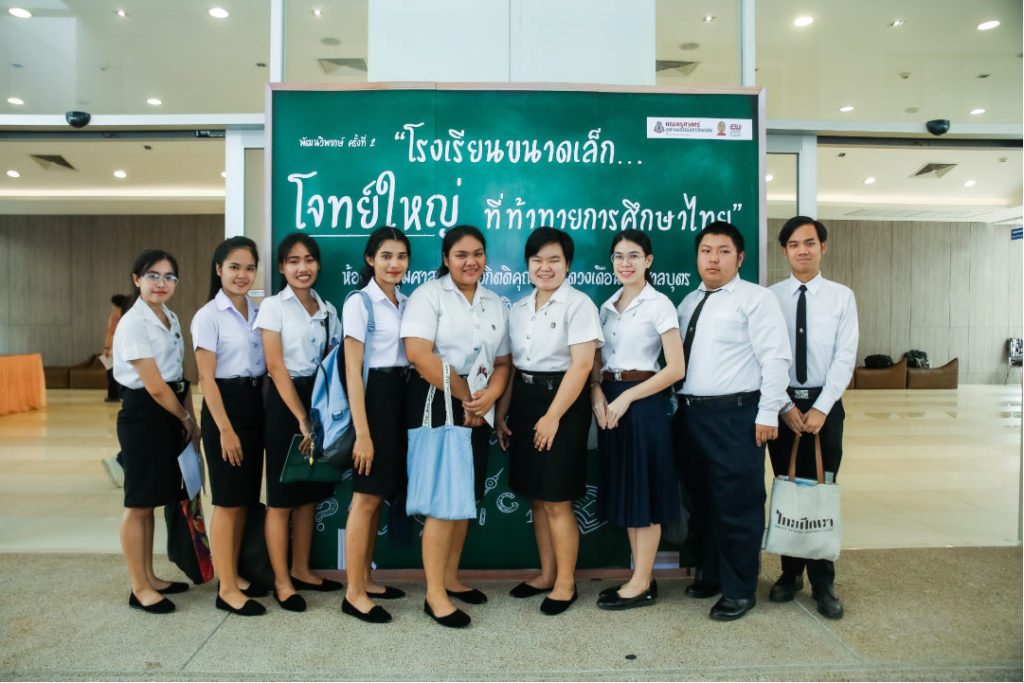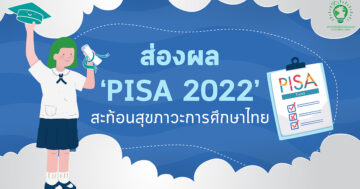On November 17, 2019 at the Prachumsuk-Achawaaumrung Building, Faculty of Education, Chulalongkorn University, the undergraduate students, Department of Development Studies, Faculty of Education, Chulalongkorn University, organized the 2nd Seminar on the Development of Critical Thinking Project.
“The small schools … a big challenge of Thai education”, the former Prime Minister Abhisit Vejjajiva, and independent academician Dr. Kraiyod Pattrawat, an expert in educational economics of the Equitable Education Fund (EEF) and Mr. Nirut Hnakpetch, the school principal of Pak Phli District Kindergarten participated in a discussion and also teachers, students of the Faculty of Education who were interested in this seminar.

Dr. Kraiyod Pattrawat, Deputy Manager of the Equitable Education Fund (EEF) said that the small schools were complex problems and were considered an important problem in solving the educational inequality in the country. The Equitable Education Fund (EEF) tried to analyze an in-depth research to solve the problems of small schools and find the clear systematic reform in order to support the systematic research process which will lead to policy proposals that will help the work of government’s education reform efficiently and sustainably. This proposed plan will be in agreement with the Equitable Education Fund (EEF), which has a limited budget of only 0.5% in the education system. We therefore set out the problem of
small protected schools in remote areas of the community that cannot be dissolved and merged.

From the in-depth analysis, the Information System for Equitable Education (iSEE) found that Thailand currently had small schools with less than 120 students per a school and the distance from the nearest neighboring school was no less than 10 kilometers, which the total
schools were 1,594 schools. Most of which were located in remote areas on mountains or islands, this group of schools currently provided education to 100,000 students. If we dissolved and merged this group of schools, it would cause the students who would travel to nearby schools for a longer distance around 10-20 kilometers.
Therefore, the Equitable Education Fund (EEF) will use the systematic research process to determine the work problems that will lead to policy proposals for the educational equality reform. For these Protected Schools, they will be able to provide quality education for children and youth in the area sustainably, consisting of 3 sub-problems: 1. Solving problems with data and evidence, 2. Resource allocation using equality principles, and 3. Innovative teaching and learning management.


- Solving problems with data and evidence (Evidence-based Reform). The Equitable Education Fund (EEF) developed the Information System for Equitable Education (iSEE), which was a large database system that allowed everyone to see the real problems. This system pointed out the protected schools on the map clearly and told exactly 1,594 schools which province they are located. And the process of developing algorithms was to analyze in-depth data and environmental factors in various dimensions. In addition, besides the distance between schools this system helped find protected schools more completely, which cannot be dissolved and merged such as the distance from home – school, geographic information, community, social anthropology, etc., in order to understand the real problems
of the families, teachers, children and families as well as to develop measures to support the protected schools which were able to provide an equitable quality education as good as medium-sized schools in general. - Resource allocation using equality principles (Equity-based Budgeting) At present, most of the protected schools are allocated with the same fund allocation formulas as normal schools in Thailand, according to budget allocation per-student subsidies of the Office of the Basic Education Commission (OBEC). There are 2 important components, subsidies per capita and a 15-year free education budget that the amount varies according to the student, and education level with the additional budget funds (Top-up) to the small school about 500-1,000 baht / person / year slightly.


This formulation of money allocation will affect schools with low student multipliers causing problems due to the ineffectiveness of the size (Lack of Economies of Scale). Since schools with less than 120 students will have basic expenses for education, there is no different from providing education to 150 or almost 200 children such as utility bills, material and equipment costs for teaching and learning, and the wages of teachers. Because the number of students is 25-50% less than medium-sized schools, these small schools do not receive sufficient resources to gain quality education. Although the top-up budget for small schools has been increased, it is still not enough to close the gap due to the not being economical to this size.
As shown in the picture, the cost structure for quality education is not non-linear. The cost of educational management will increase at a lower rate if the school has more students. It can be observed from the lines that have gradually decreasing slope but budget subsidies are increasing at a constant rate (linear), which makes small schools more likely to not have sufficient budgets to gain quality education.
On the other hand, large schools that are allocated with the same allocation formula will be enough budget left from economies of scale and are able to bring that budget to invest and hire personnel to supply better quality education.
The problem of inaccuracies in the cost structure and the allocation formula is causing problems of inequality in educational management between small schools and large schools. It can be seen that reforms to solve the inequality in the Thai education system can be made by allocating the budget with equality. (Equity-based Budgeting) There is a formula for allocating budgets that can move resources from one point to another (Redistribution), which does not need to increase the budget at all both monetary and non-monetary resources.

3.Learning innovation for educational equality. With special conditions Both limitations in terms of human resources and disadvantaged learners, the teaching and learning for young children in small schools requires innovation in education to promote equality of educational opportunities. There are
2 successful innovations at the international level, such as Multi-age Classroom and Teaching at the Right Level (TaRL), which focuses on resource management, manpower, and the limited utility environment in these small schools to maximize efficiency. Including, these innovations are able to manage education in accordance with the needs and potential of the learners individually and will directly affect the quality of learning and the development of learners.


Solving problems of small schools must be started by studying all-round information and take all relevant factors into consideration thoroughly in order to truly see the condition of the problems. The Equitable Education Fund (EEF) would like to persuade all people to look at the problems of thousands of small schools in remote areas that cannot be merged. There are many ways to solve these problems, from changing the method of allocating resources to more equitable principles and create equality of educational quality through the use of innovative learning that will enhance the quality education in the small school context in a sustainable manner.







